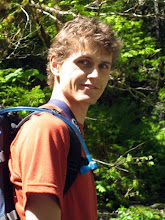Moving from Hungary's humid, busy Budapest to Poland's cool, relaxed Krakow was an easy one. Perhaps a traveler more enticed by shopping, guided tours, scams, and prostitution would have found the parting with Budapest more painful. I was ready for something else.
As I understand, Krakow was once the small capital of Poland, and holds certain historical significance. Part of this history must have been filled with wealth and enlightenment, as the Old Town is richly populated with beautiful houses, quite respectable municipal buildings, and (of course) several not entirely humble churches. With a short walk from the train station through a delightfully welcoming greenbelt, we easily found the old Royal Hotel, situated just outside the fortifications of the old city. As hotels go, the Royal Hotel is about as good (amenities, location, price) as I would ever expect, short of traveling on an absurdly large budget.
After dropping our bags, we again stepped out into the Polish morning, and began our exploration of the town. I'm sure food was first on the list, but it must not have left a lasting impression. Krakovians certainly can cook up a decent dish, but I was much more entranced by the city itself than by its culinary accomplishments. At Krakow's heart, the old town square offers an old town hall tower, the Cloth Hall, and the imposing St. Mary's Basilica, which impressed even me. The square is lined with well-preserved buildings, most of which house cafes, restaurants, hostels/hotels, or boutiques.
First: the tower. Although it is all that remains of an old town hall, it offers the imagination a spectacular, proud social center. While the doors of the tower are closed until about 10:00am, it's worth the wait. Once inside, tower attendants seem to expect some sort of fee to climb the steep stairs to admire their city. Luckily, I only found out about this expectation later, by word of mouth. Somehow, I slipped by their rules and met blue skies and red rooftops at the tower's top. If you visit Krakow, stop by this quick visual fix. The challenging step height and low arches left my thighs thicker and my back crooked, but I'll do it again on my next visit.
The Cloth Hall occupies the very center of the square, and claimed to house a museum. I gave the museum an easy miss and wandered into the highly-arched corridors, instead. The Cloth Hall gets its name from its original purpose. Today, however, the large central vault which comprises the majority of the building lends its floors to vendors of souvenirs. Many of the stalls feature one of Krakow's specialties: amber. While amber is nothing new to me, apparently Krakow has access to extraordinary amber, and gladly offers it polished and set in silver and gold for excited tourists to buy. Beyond the amber, souvenirs, vaulted corridor, and the museum, the Cloth Hall is an excellent landmark, and would effectively serve as "center of the city" for our entire stay.
About St. Mary's Basilica, I have little to offer except observations about the exterior. By this point, my interest in church interiors was low enough to merit a cup of coffee while my more interested mother explored beyond its doors. Allegedly, this was a mistake, as the interior was relatively unique. This is not just any old church, but rather a church of the Cult of Mary. My mother's prying eyes detected only a single crucifix in the entire place. Where Jesus normally features in most Catholic churches, Mary stood instead. Thankfully, the churches wonders also spilled out into the square: each hour, a bugler appears in one of the towers and plays a spiffy little tune for adoring tourists below. Most churches settle for bells, and clock towers usually feature slightly dynamic figurines, but this church employed a person to play his horn on the hour, every hour. Go Krakow!
Unlike many people who pass through Krakow, we opted not to visit the former concentration camp at Auschwitz. Instead, we made for the nearby (and altogether less depressing and less impressively historical) salt mines. Back in the day, salt was difficult to come by, and usually had to be mined from the earth in much the same manner as coal. But while coal mines usually leave workers with black lungs and a wide variety of other diseases, salt mines tended to cure ailments and leave workers in much better states of health. In all, our tour through the mines took us about 130 meters below ground, through countless chambers and caves, and past many impressive statues -- all excavated and intricately carved by the Medieval miners. Among the chambers were several chapels and churches, one of which might rival many cathedrals in Western Europe and easily outdoes most in terms of originality. Being carved from veins of salt, all of the walls and statues are translucent, and seem to glow with even the slightest amount illumination.
Anybody planning a trip to this part of the world would be wise to make Krakow a major destination. It has a small town feel without lacking entertainment and amenities, and feels only modestly touristy. On our departure from Krakow, my parents and I swore to return for a much longer stay, when next we are able. Luckily, our next destination would be a pleasant one as well.
Coming soon: Prague.
Happy. Thank you. More Please.
13 years ago


No comments:
Post a Comment